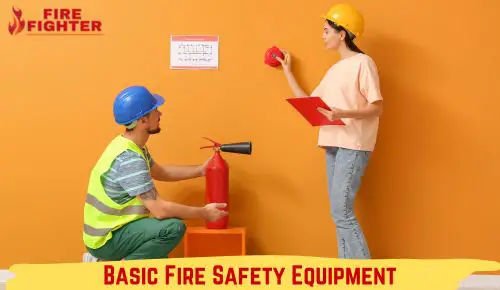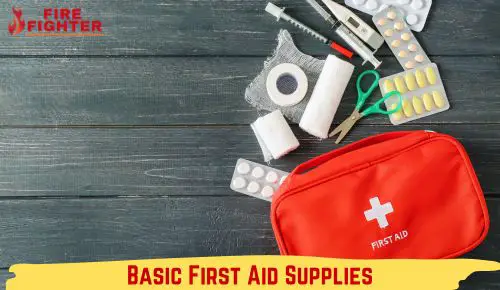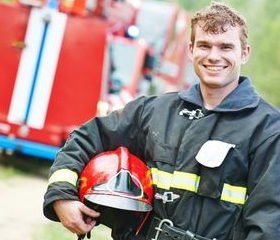What Is The Fire Safety First Aid Kit
It’s always important to be prepared for potential emergencies, especially when it comes to fire safety. While most people have heard of first aid kits, there’s another type of kit that can be just as crucial in case of a fire.
But what exactly is a fire safety first aid kit? In this blog post, we’ll take a closer look at this type of kit and what items you might find inside.
Whether you’re a homeowner, business owner, or just someone who wants to be prepared, understanding the importance of a fire safety first aid kit can be a crucial step in staying safe during an emergency.
Contents
Basic Fire Safety Equipment

Fire extinguisher:
Types: Fire extinguishers come in different types based on the class of fire they are designed to extinguish.
The most common types are Class A (for ordinary combustibles like wood and paper), Class B (for flammable liquids and gases), Class C (for electrical fires), and Class K (for kitchen fires involving cooking oils and fats).
Usage: Fire extinguishers are used to suppress small fires before they escalate.
To use a fire extinguisher, remember the acronym PASS: Pull the pin to break the tamper seal, Aim the nozzle at the base of the fire, Squeeze the handle to release the extinguishing agent, and Sweep from side to side while aiming at the base of the fire.
Placement: Fire extinguishers should be easily accessible and placed in locations where fires are likely to occur, such as in the kitchen, near fireplaces, in garages, and on each level of the home or workplace.
They should be mounted on brackets or in cabinets, and their locations should be clearly marked with signs or labels.
Fire blanket:
Purpose: A fire blanket is a flame-resistant blanket used to smother small fires. It can be used to extinguish fires on a person whose clothing is on fire or to cover and smother small fires in areas such as a kitchen stove or a trash can.
Application: To use a fire blanket, hold it by the edges and gently drape it over the fire, completely covering the flames. Avoid opening the blanket too quickly, which could cause air to fan the flames.
Leave the blanket in place for a few minutes to ensure that the fire is fully extinguished. Do not attempt to use a fire blanket on large or spreading fires.
Smoke detector:
Function: Smoke detectors are electronic devices that detect the presence of smoke and emit a loud alarm to alert occupants of a potential fire. They are typically powered by batteries or connected to the electrical system of a building.
Maintenance: Smoke detectors should be tested monthly to ensure they are functioning properly. Batteries should be replaced as needed, and the entire unit should be replaced every 10 years or as the manufacturer recommends.
Smoke detectors should be cleaned regularly to remove dust and debris that may interfere with their operation.
Following the manufacturer’s instructions for installation, testing, and maintenance is important.
Emergency escape ladder:
Use: An emergency escape ladder is a portable ladder designed to be used as a means of egress from upper floors of a building in case of a fire or other emergency.
It is typically stored in a compact form and can be quickly deployed when needed.
Storage: Emergency escape ladders should be stored in an easily accessible location near a window on each building floor above the ground floor.
They should be stored in their original packaging or in a designated bag or container to protect them from dust, moisture, and damage.
Deployment: To use an emergency escape ladder, follow the manufacturer’s instructions for deployment. Typically, the ladder is hooked over the windowsill or another sturdy anchor point, and the rungs are released to create a stable means of escape.
Practice using the ladder during drills or rehearsals to familiarize yourself with its operation and ensure that it is in good working condition.
Basic First Aid Supplies

Bandages:
Assorted sizes and types: A first aid kit should have a variety of bandages in different sizes and types, including adhesive bandages (commonly known as “band-aids”) in various sizes, as well as elastic or cloth bandages for larger wounds or injuries.
Usage: Bandages are used to cover and protect wounds, cuts, or abrasions, helping to prevent infection and promote healing. They should be applied according to the manufacturer’s instructions and changed regularly or as needed.
Adhesive tape:
Usage: Adhesive tape is used to secure bandages or dressings in place. It should be used to firmly attach bandages without restricting blood flow or causing discomfort to the person receiving first aid.
It is important to use medical-grade adhesive tape that is hypoallergenic and safe for use on the skin.
Antiseptic wipes:
Usage: Antiseptic wipes are used to clean wounds or cuts to prevent infection. They contain antiseptic solutions or disinfectants that help kill germs and reduce the risk of infection.
Antiseptic wipes should be used as directed, and any excess solution should be wiped away before applying a bandage or dressing.
Sterile gauze pads:
Usage: Sterile gauze pads are used for dressing wounds, particularly those that are larger or deeper. They provide a sterile barrier to help prevent infection and promote healing.
Sterile gauze pads should be used to cover wounds and secured in place with adhesive tape or bandages.
Scissors:
Usage: Scissors are used to cut bandages or clothing when administering first aid. They should have blunt tips to prevent accidental injury and should be kept sharp and clean for effective use.
Scissors should be used with caution and only for their intended purpose.
Tweezers:
Usage: Tweezers are used to remove splinters, thorns, or other foreign objects from the skin.
They should be used with clean hands and a gentle, steady grip to avoid causing further injury. After use, tweezers should be cleaned and sterilized.
Disposable gloves:
Usage: Disposable gloves are used to protect the person administering first aid from coming into contact with bodily fluids or potentially infectious materials.
They should be used when providing first aid, particularly when dealing with open wounds or performing CPR. Disposable gloves should be worn according to the manufacturer’s instructions and properly disposed of after use.
CPR face shield or mask:
Usage: A CPR face shield or mask is used during CPR procedures to provide a barrier between the person administering CPR and the person receiving it.
It helps prevent the transmission of germs and protects both parties. CPR face shields or masks should be used in accordance with CPR guidelines and properly cleaned or disposed of after use.
Instant cold pack:
Usage: An instant cold pack is used to reduce swelling or inflammation caused by sprains, strains, or other injuries.
It should be activated according to the manufacturer’s instructions and applied to the affected area for the recommended duration.
Cold packs should not be applied directly to the skin and should be wrapped in a towel or cloth before use.
Disposable rescue blanket:
Usage: A disposable rescue blanket, also known as a space blanket or emergency blanket, provides warmth in case of shock or exposure to cold temperatures.
It is made of a lightweight, reflective material that helps retain body heat.
Rescue blankets should be used to cover the person in need, and additional insulation should be provided as needed.
First aid manual or instruction booklet:
Usage: A first aid manual or instruction booklet guides how to administer first aid in various situations. It should be kept in
Additional Fire Safety Items
In addition to the basic fire safety equipment mentioned earlier, several other items can enhance fire safety measures. These include:
Fire escape plan: A fire escape plan is crucial to fire safety in any home or building.
It should include a clear and well-practiced plan for evacuation in case of a fire, with designated escape routes, a designated meeting point outside the building, and a plan for individuals with mobility limitations or disabilities.
A fire escape plan should be posted in visible areas of the building, and all residents or occupants should be familiar with it.
Fire-resistant safety box: A fire-resistant safety box or cabinet is designed to protect important documents, valuable items, and electronic devices from fire damage.
These boxes are made of fire-resistant materials and are designed to withstand high temperatures for a specified period. They provide an added layer of protection for irreplaceable items during a fire emergency.
Fireproof safe: A fireproof safe is another option for protecting important documents, valuable items, and electronic devices from fire damage.
These safes are designed to withstand high temperatures and protect the contents inside from flames and smoke.
Fireproof safes come in various sizes and fire resistance levels, so choosing one that meets your specific needs is important.
Fire-resistant clothing or blankets: Fire-resistant clothing, such as fire-resistant gloves, jackets, and pants, can be used by firefighters or individuals who work in high-risk environments where exposure to flames or extreme heat is a possibility.
Fire-resistant blankets are also available and can be used to smother small fires or wrap around a person to protect them from flames in case of a fire emergency.
Fire suppression system: Fire suppression systems, such as fire sprinklers or fire suppression extinguishing agents, can be installed in commercial buildings or homes to suppress or extinguish fires quickly.
These systems are designed to automatically detect and suppress fires, reducing the risk of fire spreading and causing extensive damage.
Qualified professionals should install and maintain fire suppression systems according to local fire codes and regulations.
Fire-resistant coatings or sealants: Fire-resistant coatings or sealants can be applied to walls, ceilings, or other surfaces to provide an additional layer of fire protection.
These coatings are designed to resist flames and heat, helping to prevent the spread of fire and protect the structural elements of a building.
Trained professionals should apply fire-resistant coatings or sealants in accordance with the manufacturer’s instructions and local building codes.
Fire safety signs and labels: Fire safety signs and labels, such as exit signs, fire extinguisher signs, and emergency evacuation signs, are essential for providing clear guidance during a fire emergency.
These signs should be clearly visible, properly illuminated, and strategically placed throughout a building.
Fire safety signs and labels help individuals locate emergency exits, fire extinguishers, and other fire safety equipment quickly and easily during a fire emergency.
Personal Medications and Supplies
Personal medications and supplies are important to have on hand in case of a medical emergency or when access to medical care may be limited. These may include:
Prescription medications: If you have any chronic medical conditions requiring prescription medications, it’s important to have an adequate supply of these medications.
This may include medications for conditions such as asthma, diabetes, heart disease, or other chronic health conditions. Make sure to regularly check the expiration dates on your medications and replace them as needed.
Over-the-counter medications: Basic over-the-counter medications such as pain relievers, antacids, anti-diarrheal medications, cough and cold medications, and allergy medications can be useful in addressing minor ailments or symptoms during an emergency situation.
Having a small supply of these medications can help manage common health issues that may arise during an emergency.
First aid kit: A well-stocked first aid kit is an essential item to have on hand for any emergency situation.
It should include items such as adhesive bandages, gauze pads, adhesive tape, antiseptic wipes or solution, scissors, tweezers, disposable gloves, CPR face shield or mask, instant cold pack, and a first aid manual or instruction booklet.
A first aid kit can help you address minor injuries or medical needs until professional medical care is available.
Epinephrine auto-injector: If you have a known severe allergic reaction (anaphylaxis) to certain allergens, such as insect bites or certain foods, it’s important to have an epinephrine auto-injector.
This is a potentially life-saving medication that can be used to treat severe allergic reactions.
Personal medical information: It’s important to have a record of your personal medical information in case of an emergency.
This may include your medical history, allergies, current medications, and emergency contact information. Keep a printed or electronic copy of this information in a safe and easily accessible place.
Medical supplies: If you have any specific medical supplies that are required for your health condition, such as insulin syringes, inhalers, or glucose monitoring devices, make sure to have an adequate supply of these items on hand.
It’s important to regularly check the expiration dates on these supplies and replace them as needed.
It’s important to regularly review and update your personal medications and supplies to ensure that they are current and meet your specific health needs.
Store these items in a safe, dry, and easily accessible location, and make sure that other household members or caregivers know their location and how to use them if needed.
Always follow proper storage and disposal instructions for medications and medical supplies, and consult with your healthcare provider for any specific medical advice or recommendations.
Storage and Maintenance
Proper storage and maintenance of fire safety and first aid supplies are essential to ensure their effectiveness and readiness during an emergency. Here are some guidelines for storing and maintaining fire safety and first aid supplies:
Fire Safety Supplies
Fire extinguisher: Store fire extinguishers in a cool, dry place that is easily accessible and away from heat sources or open flames.
Check the pressure gauge regularly to ensure that it is in the green zone, indicating that the extinguisher is charged and ready for use.
Follow the manufacturer’s instructions for maintenance, such as periodic inspections or refilling/recharging, and immediately replace any damaged or expired fire extinguishers.
Fire blanket: Store fire blankets in a location that is easily accessible and clearly marked.
Make sure it is kept clean and free from dust or debris. Inspect the fire blanket regularly for any signs of damage or wear and replace it if necessary.
Smoke detector: Install smoke detectors in every bedroom, outside each sleeping area, and on every level of your home.
Follow the manufacturer’s instructions for installation and maintenance, such as regular testing and battery replacement. Replace smoke detectors that are more than 10 years old or show signs of malfunction.
Emergency escape ladder: If you have an emergency escape ladder, store it in a location that is easily accessible from the designated escape route, such as near a window or balcony.
Make sure it is kept clean and free from damage, and regularly inspect it to ensure it is in good working condition.
First Aid Supplies
First aid kit: Store the first aid kit in a cool, dry place that is easily accessible and clearly marked. Keep it away from moisture or extreme temperatures that may affect the integrity of the supplies.
Regularly check the contents of the first aid kit to ensure that all items are present, in good condition, and within their expiration dates. Replace any used or expired items promptly.
Personal medications and supplies: Store personal medications and supplies in a secure, cool, and dry place, away from direct sunlight or extreme temperatures.
Follow the storage instructions provided by your healthcare provider or the medication manufacturer. Regularly check the expiration dates on medications and supplies and replace them as needed.
Keep a record of your personal medical information in a safe and easily accessible place, and update it regularly.
Personal protective equipment (PPE): Store PPE, such as gloves, face masks, goggles, or face shields, in a clean and dry place that is easily accessible.
Follow the manufacturer’s instructions for storage and maintenance, such as cleaning or replacement. Make sure that PPE is readily available and in good condition when needed during an emergency.
Regularly review and update your fire safety and first aid supplies to ensure that they are in good condition and meet your specific needs.
Train yourself and household members on how to properly use and maintain these supplies, and familiarize yourself with the instructions provided by the manufacturer or healthcare provider. In case of any doubts or questions, consult with relevant professionals or seek guidance from certified sources.
Conclusion
A fire safety first aid kit is a critical tool for preparedness in case of a fire emergency. It should be stocked with fire safety equipment, basic first aid supplies, personal medications and supplies, and PPE.
Proper storage and maintenance of these supplies are vital to ensure their effectiveness when needed.
Regularly checking and replacing expired or damaged items, following the manufacturer’s instructions, and training oneself and household members on how to use and maintain the kit properly are essential steps for ensuring its readiness.
A well-maintained fire safety first aid kit can help mitigate the risks of fire-related injuries and save lives in an emergency situation.

Hi, I m Aaron Smith, a firefighter, and creator of Firefighterline.com, a website that provides top-notch training courses for firefighting organizations. After completing my studies, I quickly rose through the fire service ranks, eventually becoming Captain at one of the busiest fire departments in the state.
